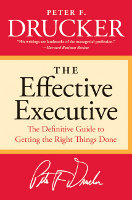About the Author
Born in Austria in 1909, Peter Drucker is one of the most influential business writers of the 20th century. He taught management beginning with 1950 until 2005 (when he died) at New York University and Claremont Graduate University. He wrote more than 30 books on business and management, most of them translated in over 20 languages. BusinessWeek Magazine called him: “the man who invented management”.
Book description
The first edition of “The Effective Executive” appeared in 1966 and it was republished several times since. If most of the management books are on how to conduct other peoples, this book is about how to manage ourselves. The focus of the book is on the executive, or decision maker, and what he or she must do in order to be effective.
In the first part of the book Drucker clarifies 3 essential aspects:
- who is the executive
- why effectiveness is a vital subject
- what is effectiveness
The second part of the book, the largest, describes thoroughly the 5 habits that determines the effectiveness of an executive:
- understand and control his time usage
- focus on contribution and results
- build on his own strengths and on the strengths of his superiors, colleagues and subordinates
- focus on the areas where superior performance leads to outstanding results
- make effective decisions
My favorite quote
Effectiveness, in other words, is a habit; that is, a complex of practices. And practices can always be learned. Practices are simple, deceptively so; even a seven-year-old has no difficulty in understanding a practice. But practices are always exceedingly hard to do well. They have to be acquired, as we all learn the multiplication table; that is, repeated ad nauseam until “6 x 6 = 36” has become unthinking, conditioned reflex, and firmly ingrained habit. Practices one learns by practicing and practicing and practicing again.
My Comments
I will not get into the details of the book, as I don’t want this review to replace reading the book. By contrary, my goal is to make you curious enough to read it. This is why I will briefly comment only on two topics:
Who is the executive
The correct identification of the decision makers within an organization must start from a key concept, namely, from responsibility. This will help avoiding the trap of automatically putting equal between managers and executives (decision makers). Why would it be wrong? Because Drucker is saying that not all managers are decision makers and decision makers are not all managers. Then, what is the correct definition of an executive? Based on the concept of responsibility, we can see that a modern organization needs two types of characters in positions that involve responsibility, authority and decision-making capacity: The Manager – meaning the person managing a group of people who are his subordinates – and The Individual Professional Contributor or, the knowledge worker, as Drucker likes to call him.
So, in the modern organization, a manager or individual professional contributor is an executive if by virtue of his position or knowledge, he is responsible for a contribution that materially affects the capacity of the organization to perform and to obtain results. This may be the capacity of a business to bring out a new product or to obtain a larger share of a given market. It may be the capacity of a hospital to provide bedside care to its patients, and so on. Such a man (or woman) must make decisions; he cannot just carry out orders. He must take responsibility for his contribution.
Building on strengths
Any person, object or situation has both strengths and weaknesses. As a result, there are two ways on which we can act: cover/correct weaknesses or exploit strengths. What is the correct path? Drucker says that, in order to get results, you must use all available strengths of your partners, superiors or of your own. Performance can only be build on the strengths and, therefore, harnessing strengths is the only purpose of the organization.
Why is this idea so important? Because there is a bad tendency, especially when it comes to personal assessment, to look for ways to remedy the situation when someone concludes he has weaknesses in some area. The idea to correct is not wrong in itself but the purpose of the correction must be the right one. There is no universal genius and nobody should try to be good at everything. Correction must be aimed at controlling the negative effects (damage control). A very interesting book on this subjects is “Now, Discover Your Strengths” by Marcus Buckingham.
Unlike other practices that determine effectiveness, harnessing strengths, is both a practice and an attitude. If we discipline ourselves to look for the potential of a person or situation and not for the weaknesses, we develop the habit of identifying and building on strengths.
Conclusion
Although written in simple words and easy to read, the book is not superficial. It is not the “5 steps to effectiveness” kind of book. It is a competent analysis that manages to make tangible a vital concept for an executive. With clear ideas and eloquent examples, the book worth reading and I recommend it to every person aspiring to a position of responsibility.
